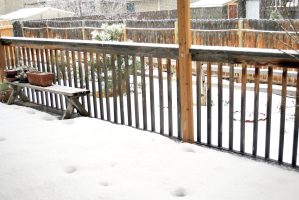 When you think of your patio and hardscaping wear and tear, what time of the year do you think of? Spring showers, summer storms, or all the leaves of autumn might come to mind. It might surprise you to learn then that the majority of the damage done to your hardscaping happens in the winter. The changes in temperature, the moisture, chemicals, and less then delicate treatment of your patio makes for most of the wear and tear it will experience during the year. However, there are things you can do to protect your patio and hardscaping.
When you think of your patio and hardscaping wear and tear, what time of the year do you think of? Spring showers, summer storms, or all the leaves of autumn might come to mind. It might surprise you to learn then that the majority of the damage done to your hardscaping happens in the winter. The changes in temperature, the moisture, chemicals, and less then delicate treatment of your patio makes for most of the wear and tear it will experience during the year. However, there are things you can do to protect your patio and hardscaping.
Snow and Ice
You might think to yourself, “what help does clearing the snow and ice provide? It’s just water; it’s not doing anything to hurt my hardscaping.” And water isn’t harmful on its own. Not in its solid state. Not in its liquid state. There is a problem, however, when it switches between the states of solid and liquid. When water is liquid, it can get into the pores and cracks of your hardscaping. When the temperature gets below 32°F (0°C) the water freezes becoming ice, and as it freezes it expands, forcing the pores and cracks of your hardscaping larger. When the temperatures get above the freezing point, the ice turns back into liquid water, and now more water can flow into the larger pores and cracks. And this will happen, over, and over again during the winter, especially in a temperate climate like Maryland’s. Clearing the snow and ice from your hardscaping not only makes it safer to walk on, but prevents this damaging cycle from starting in the first place.
Chemicals
However, the moisture and the temperature were only the first two things threatening your hardscaping in the winter. Chemicals are the next. Some de-icing chemicals can be corrosive to concrete and natural stone, so it’s important to be careful about the chemicals you use and to check with the manufacturer or supplier of your hardscaping materials as to whether de-icing chemicals will harm them. Even just salt can damage some stones, or exacerbate the problem of the freezing-thawing cycle. So if you have ice on your hardscaping that you weren’t able to get rid of while it was snow, it’s best to put down sand or cat litter for traction.
Rough Treatment
The third danger to your hardscaping during the winter is the rough treatment it gets during the winter. Wearing spikes for traction on ice can damage natural stone, pavers, and concrete, especially when you stomp them to get the snow off your boots. Using a metal bladed snow shovel can also scratch your hardscaping. To prevent damaging your hardscaping you should make sure your use a plastic snow shovel, or a metal shovel with a rubber or plastic edge when you clear it off.
Fix Up the Little Cracks and Scratches
Since you’ve cleared your hardscaping and are doing your best to take good care of it you should take the opportunity to fix what you can while it’s winter. Fill in cracks, replace broken pavers, and reseal it if you haven’t sealed it in a while. Fixing the little problems will prevent them from becoming bigger ones later.
Need Help With Your Hardscaping? Call The Atlantic Maintenance Group.
It’s easy to get overwhelmed with your day to day living while trying to maintain your home’s landscaping, especially during the winter. The Atlantic Maintenance Group is here to help. We offer a wide variety of maintenance, landscaping, and general contracting services.
To get your free quote today, give us a call at 410-768-4720 or contact us via our website today.
You can also follow us on Facebook, Twitter, Pinterest, and Google+ to see how we’re growing!
